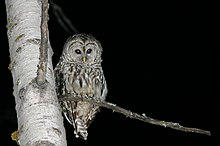
Back نشاط ليلي Arabic Heyvanlarda gecə həyat tərzi Azerbaijani নিশাচর Bengali/Bangla شەودەری CKB Noční živočich Czech Natdyr Danish Noktulo Esperanto Nocturnidad Spanish Gautartasun Basque شبگردی Persian
This article needs additional citations for verification. (May 2012) |

Nocturnality is a behavior in some non-human animals characterized by being active during the night and sleeping during the day. The common adjective is "nocturnal", versus diurnal meaning the opposite.
Nocturnal creatures generally have highly developed senses of hearing, smell, and specially adapted eyesight.[1] Some animals, such as cats and ferrets, have eyes that can adapt to both low-level and bright day levels of illumination (see metaturnal). Others, such as bushbabies and (some) bats, can function only at night. Many nocturnal creatures including tarsiers and some owls have large eyes in comparison with their body size to compensate for the lower light levels at night. More specifically, they have been found to have a larger cornea relative to their eye size than diurnal creatures to increase their visual sensitivity: in the low-light conditions.[2] Nocturnality helps wasps, such as Apoica flavissima, avoid hunting in intense sunlight.
Diurnal animals, including humans (except for night owls), squirrels and songbirds, are active during the daytime. Crepuscular species, such as rabbits, skunks, tigers and hyenas, are often erroneously referred to as nocturnal. Cathemeral species, such as fossas and lions, are active both in the day and at night.
- ^ Agee, H. R.; Orona, E. (1988). "Studies of the neural basis of evasive flight behavior in response to acoustic stimulation in Heliothis zea (Lepidoptera: Noctuidae): organization of the tympanic nerves". Annals of the Entomological Society of America. 81 (6): 977–985. doi:10.1093/aesa/81.6.977.
- ^ Hall, M. I.; Kamilar, J. M.; Kirk, E. C. (2012). "Eye shape and the nocturnal bottleneck of mammals". Proceedings of the Royal Society B: Biological Sciences. 279 (1749): 4962–4968. doi:10.1098/rspb.2012.2258. PMC 3497252. PMID 23097513.
© MMXXIII Rich X Search. We shall prevail. All rights reserved. Rich X Search